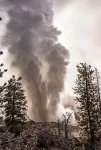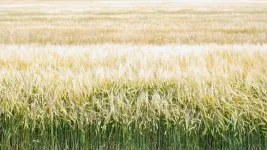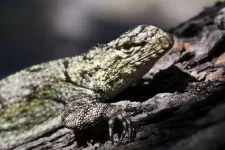American Geophysical Union
25 July 2023
AGU Release No. 23-29
For Immediate Release
This press release and accompanying multimedia are available online at:
https://news.agu.org/press-release/petrified-trees-reveal-yellowstone-geysers-ongoing-battle-with-drought/
AGU press contact:
Liza Lester, +1 (202) 777-7494, news@agu.org (UTC-4 hours)
Contact information for the researchers:
Shaul Hurwitz, U.S. Geological Survey, shaulh@usgs.gov (UTC-7 hours)
WASHINGTON — Yellowstone’s Steamboat Geyser has had decades-long dry spells brought on by a history of droughts, a new study finds. With global temperatures on the rise, the American West is projected to become drier. Sustained drought in this region could slow down, and possibly halt, Yellowstone National Park’s famous geyser eruptions, the researchers say.
“Even small changes in precipitation could affect the interval between eruptions,” explained Shaul Hurwitz, a hydrologist at the United States Geological Survey (USGS) who led the study. “So more water means more frequent eruptions, while less water means less frequent eruptions.”
Geysers need very specific conditions to form, including a water source, heat supply, and the right geologic plumbing. Environmental conditions such as drought can tip that balance and cause geysers to go dormant. The new study, published in Geochemistry, Geophysics, Geosystems, an AGU journal that covers research on the chemistry, physics, geology and biology of Earth and planetary processes, used partially mineralized wood by Steamboat Geyser to reconstruct its past periods of inactivity and determine what caused the geyser’s dry spells.
Steamboat, the world’s tallest active geyser, can spray water up to about 115 meters (377 feet) into the air for as long as 90 minutes at a time. Unlike the park’s Old Faithful Geyser, Steamboat does not erupt on a predictable schedule, with eruption intervals ranging from just three days to 50 years, according to the USGS. Now, researchers are looking to understand why the geyser’s activity has waxed and waned over the centuries.
When Steamboat erupts, the geyser’s heated water spray coats nearby trees in silica, a mineral that can prevent decomposition. This silica mist slowly smothers the trees, eventually killing them while preserving the wood’s structure. As a result, dead trees surrounding the geyser can be preserved for centuries longer than usual, making them a useful tool for studying the geyser’s history.
“In Yellowstone, you rarely find any wood, even dead wood, that’s more than 300 years old because the fungi and other bacteria decompose it,” Hurwitz said. “The silica essentially protects the tree from the fungi. For us, this is an advantage because if they weren’t silicified we wouldn’t have any trees to date.”
Lodgepole pines make up nearly all of Yellowstone’s forests. However, they have an average lifespan of only 150 to 200 years. Hurwitz and his team took advantage of this preservation process and collected silicate wood samples from within 14 meters (46 feet) of the geyser vent. Through radiocarbon dating, they found that the tree samples clustered around three time periods: the late 15th Century, mid-17th Century and late 18th Century.
“Water that is erupting from the geyser is silica-rich, and when silica precipitates it clogs pathways that allow the trees to respire, photosynthesize and grow,” Hurwitz explained. “For us, this indicates that when trees grow right near the mound there are no eruptions.”
Hurwitz and his team matched the three periods of tree growth around the geyser to regional climate records and found that droughts occurred during the same time that the trees grew. These environmental conditions most likely reduced the local water supply, preventing Steamboat from erupting and allowing the trees to grow — but the geyser hasn’t remained dormant for long.
“In the case of Steamboat, we did not find any tree remnant of silicified wood that had more than 10 or 20 annual rings, which suggests to us that trees never grew big around that area,” Hurwitz said. “So, there wasn’t an extended period of many decades or centuries with continuous growth.”
But with global temperatures on the rise, extended drought in America’s West could further diminish Yellowstone’s geyser activity.
“As we’re headed toward what’s predicted to be a warmer and drier climate in the 21st century, we might expect to see the geysers go to totally different behavior in terms of the interval between their eruptions — erupting less frequently, and some of them might even go extinct,” Hurwitz said.
Popular geysers such as Old Faithful could become less “faithful” to their eruption schedules as their water supply lessens. According to Hurwitz, these changes in geyser activity could have long-term implications for how Yellowstone National Park manages visitation overall.
###
AGU (www.agu.org) is a global community supporting more than half a million advocates and professionals in Earth and space sciences. Through broad and inclusive partnerships, AGU aims to advance discovery and solution science that accelerate knowledge and create solutions that are ethical, unbiased and respectful of communities and their values. Our programs include serving as a scholarly publisher, convening virtual and in-person events and providing career support. We live our values in everything we do, such as our net zero energy renovated building in Washington, D.C. and our Ethics and Equity Center, which fosters a diverse and inclusive geoscience community to ensure responsible conduct.
Notes for Journalists: This study is published in Geochemistry Geophysics, Geosystems with open access. Neither the paper nor this press release is under embargo. View and download a pdf of the study here.
Paper title:
“The Relation Between Decadal Droughts and Eruptions of Steamboat Geyser in Yellowstone National Park, USA”
Authors:
Shaul Hurwitz, U.S. Geological Survey, Volcano Science Center, Menlo Park, California, US
John King, Lone Pine Research, Bozeman, Montana, USA
Gregory Pederson, U.S. Geological Survey, Northern Rocky Mountain Science Center, Bozeman, Montana, USA
Mara Reed, University of California, Berkeley, Berkeley, California, USA
Lauren Harrison, U.S. Geological Survey, Volcano Science Center, Menlo Park, California, US
Jefferson Hungerford, Yellowstone Center for Resources, Yellowstone National Park, WY, USA
R. Greg Vaughan, U.S. Geological Survey, Astrogeology Science Center, Flagstaff, Arizona, USA
Michael Manga, University of California, Berkeley, Berkeley, California, USA
END



